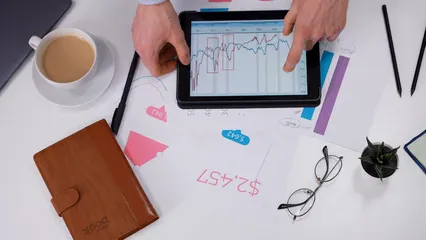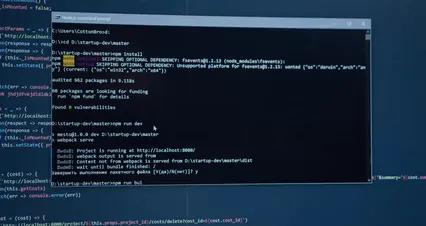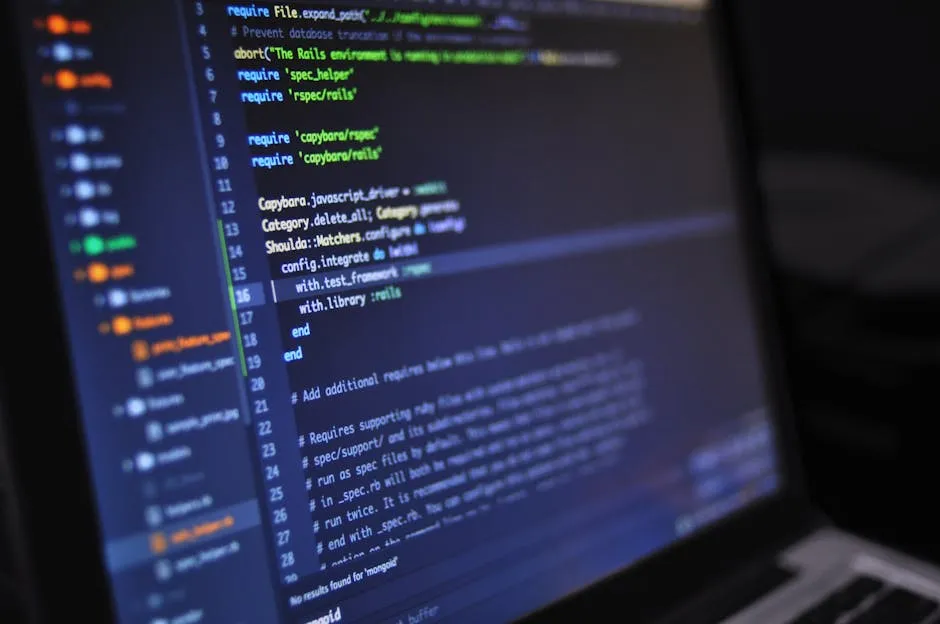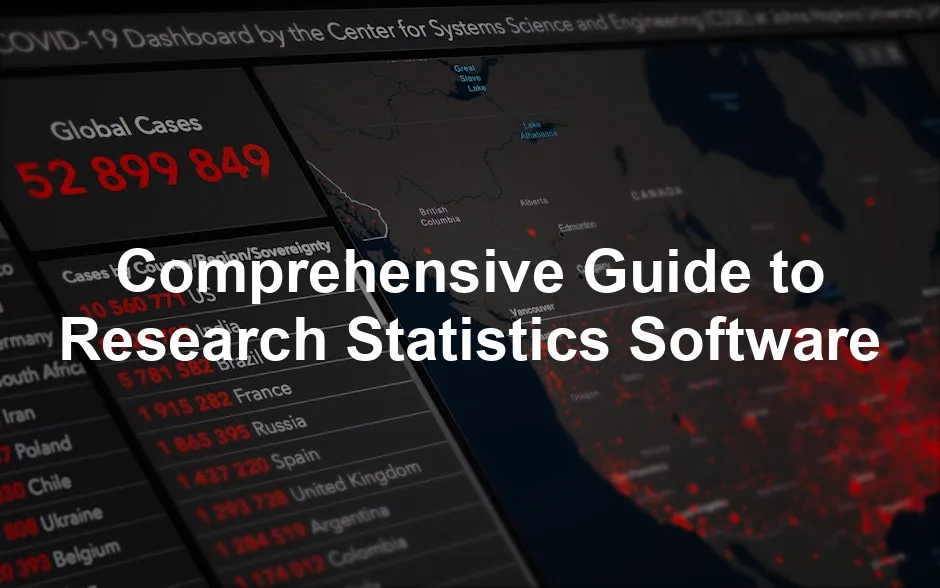Introduction
Statistics software plays a crucial role in research. It enhances data analysis, enabling researchers to draw accurate conclusions. These tools help save time and reduce errors in complex datasets. With a growing variety of software options, researchers can choose tools that best fit their needs.
Speaking of tools, if you’re looking for a comprehensive solution, check out the SPSS Statistics Software. It’s perfect for those who want to dive deep into data without drowning in complexity!
Summary and Overview
This article aims to explore various research statistics software available today. We will discuss the importance of selecting the right software tailored to your specific research objectives. Sections include software comparisons, feature breakdowns, and expert recommendations to aid your decision-making. Whether you’re conducting academic research or industry analysis, finding the right tool can significantly impact your results.
If you’re also interested in data visualization, don’t miss the Tableau Software. It’s a favorite among data analysts for creating stunning visuals that tell a story!

Understanding Research Statistics Software
Definition and Importance
Research statistics software refers to programs designed for statistical analysis of data. These tools help researchers manage, analyze, and visualize data efficiently. They play a vital role in enhancing both the accuracy and speed of data analysis.
Using statistical software brings several key benefits. First, it saves time by automating complex calculations. Second, it reduces the risk of human error in data handling. Lastly, these tools can manage large datasets that are often unmanageable through manual methods.
By utilizing research statistics software, you can focus more on interpreting results rather than getting lost in the details of data processing. This makes the research process smoother and more effective.
For those who prefer coding, the R Programming Language is an excellent choice. It’s powerful for statistical analysis and comes with a supportive community!

Types of Research Statistics Software
When it comes to research statistics software, options abound. They can be broadly categorized into proprietary software, open-source solutions, and freeware options. Each category offers unique features and capabilities that cater to different research needs.
Proprietary Software
Proprietary software is often equipped with robust features and dedicated support. This software is usually subscription-based and designed for specific industries.
SPSS
SPSS, or Statistical Package for the Social Sciences, is popular among social scientists. It has a user-friendly interface, making it accessible to beginners. The software excels at descriptive statistics and regression analysis. However, it has a steep price tag, which may not suit all budgets. Its reliance on a graphical user interface limits advanced users seeking deeper customization.
For those using SPSS, troubleshooting can be crucial. You might find helpful resources in this macos ibm spss statistics fix 28.1.1 guide.
SAS
SAS, or Statistical Analysis System, is favored in industries like healthcare and finance. It offers powerful statistical capabilities and excellent data management features. Users appreciate its extensive documentation and support. However, the learning curve can be intimidating for newcomers. Additionally, SAS is expensive, making it less accessible for smaller research teams or independent researchers.
If you’re interested in understanding crime statistics using SAS, check out this arkansas crime statistics analysis.
Stata
Stata is a highly regarded tool in economics and social sciences. Its strengths lie in its advanced programming features and versatility in handling complex data. Stata provides a wide range of statistical functions, making it suitable for both academic and professional use. While its user interface is generally straightforward, new users may find it challenging at first. The cost can also be a significant factor for those on a tight budget.
For a more budget-friendly option, consider checking out jamovi Statistical Software. It’s user-friendly and perfect for those new to statistics!

Open-Source Software
Open-source software is an excellent choice for those seeking flexibility and customization without the associated costs of proprietary software.
R
R is a powerful programming language specifically for statistical computing. It boasts an active community that continually contributes packages and updates. R excels in data visualization and statistical modeling, making it a favorite among statisticians. However, its steep learning curve can be daunting for beginners unfamiliar with coding. The lack of a graphical user interface might also deter some users.
For a comprehensive resource on statistical formulas, refer to this ap statistics formula sheet.
Python (with SciPy, Pandas)
Python, combined with libraries like SciPy and Pandas, is another popular choice for data analysis. Its versatility allows researchers to perform statistical analysis, data manipulation, and visualization. Python is easy to learn, especially for those already familiar with programming. However, its statistical capabilities may not match specialized software like SPSS or SAS. Users often need to install additional libraries for advanced statistical functions, which can be a barrier for some.
If you’re interested in mastering Python for data analysis, grab a copy of the Python for Data Analysis Book. It’s a great resource for beginners!
Explore an introduction to statistical learning with Python in this an introduction to statistical learning with python book length article.

Freeware Options
Freeware options provide a cost-effective way to conduct statistical analysis without sacrificing functionality.
JASP
JASP is designed as a user-friendly alternative to SPSS, offering a simple interface with drag-and-drop functionality. It supports Bayesian analysis alongside classical methods. It’s great for educational purposes and small-scale projects. However, it may lack some advanced features found in more established software.
For those looking for a great guide on Bayesian methods, consider the Bayesian Data Analysis Book. It’s a fantastic resource for understanding this complex topic!

jamovi
jamovi is another excellent free software that aims to provide a user-friendly experience. It operates similarly to SPSS but is much more accessible. It allows for easy data management and analysis without coding knowledge. However, like JASP, it may not support the full range of statistical procedures required for complex research.
In summary, the choice of research statistics software largely depends on your specific needs, budget, and familiarity with statistical methods. Each type of software has its strengths and weaknesses, so consider what features matter most to you.

Comparing Features of Popular Statistics Software
User Interface and Usability
User interface is key to a positive experience. A well-designed interface makes data analysis smoother. Software like SPSS and JMP features intuitive, drag-and-drop layouts. These designs cater to users with varied experience levels. On the other hand, R and Python require coding knowledge, which can be intimidating for beginners. Easier-to-navigate interfaces foster confidence, allowing users to focus on analysis rather than getting stuck in technicalities. Always consider usability when choosing a software tool; it can significantly impact your productivity.
If you want to learn more about effective data visualization, grab a copy of the Data Visualization Books to enhance your skills!

Data Management Capabilities
Data management capabilities differ widely among statistics software. Tools like SPSS and SAS excel in data import, cleaning, and manipulation. They offer built-in functions for handling missing values and outliers. Conversely, open-source options like R and Python provide flexibility but require additional packages for similar functions. If your research involves large datasets, prioritize software with robust data management features. Efficient data handling saves time and enhances the accuracy of analyses, so choose wisely.

Statistical Analysis Functions
The range of statistical functions available is crucial for effective analysis. SPSS and SAS offer extensive packages for advanced statistical modeling. They include support for regression, ANOVA, and time-series analysis. In contrast, R and Python boast a vast ecosystem of libraries, enabling a wider array of statistical techniques. While proprietary software often comes with user-friendly interfaces, open-source tools can deliver unmatched flexibility. Evaluate your specific statistical needs to determine the best fit for your research.

Visualization Tools
Effective data visualization is essential for conveying findings. Many software options provide powerful visualization tools. SPSS and Tableau excel in creating interactive graphs and dashboards. These tools help transform raw data into meaningful insights. R, with its ggplot2 package, offers advanced customization for visualizations. However, it may require a steeper learning curve. Prioritize software that allows for easy and effective visualization, as this can enhance the clarity of your research presentations. Good visuals can make complex data more accessible and engaging.

Best Practices for Choosing the Right Software
Assess Your Research Needs
Evaluating your research needs is the first step in selecting software. Consider your specific objectives and the type of analysis required. Are you conducting basic descriptive statistics or complex modeling? Understanding these factors will guide your decision. Make a list of essential features you need, such as data management capabilities and statistical functions. This clarity will streamline your search.
To further your research skills, consider investing in Statistical Analysis Textbooks. They provide a solid foundation for both beginners and advanced users!

Budget Considerations
Cost is a significant factor in software selection. Free options like R and jamovi offer robust features at no cost. However, they may lack the support and user interface of paid software. Proprietary software, like SPSS and SAS, can provide extensive features but often comes with high licensing fees. Always weigh your budget against your research requirements. Finding the right balance ensures you invest wisely in software that meets your needs without overspending.

Learning Curve and Support
Choosing the right statistics software often depends on how easy it is to learn. Some tools, like SPSS and JASP, offer intuitive interfaces. You can start analyzing data quickly without extensive training. Others, such as R and Python, may require programming skills, which can be intimidating for beginners.
Support resources play a vital role in your learning experience. Many software options provide extensive documentation, video tutorials, and user forums. These resources can help you troubleshoot issues and learn new features. Always check if the software you choose has a supportive community or dedicated customer service. This support can make a significant difference in your overall experience.

Case Studies: Real-World Applications of Statistics Software
Academic Research
In academic settings, software like SPSS is widely used. For instance, researchers at a university conducted a study on student performance. They utilized SPSS to analyze survey data from over 1,000 students. The results revealed key factors affecting academic success, such as study habits and class attendance. By using SPSS, the researchers not only saved time but also ensured accurate data analysis, leading to impactful findings that informed academic policies.

Industry Applications
In the healthcare sector, statistics software is crucial for decision-making. For example, hospitals use SAS to analyze patient data. By examining trends in patient outcomes, healthcare professionals can identify which treatments are most effective. This data-driven approach helps improve patient care and optimize resource allocation. With SAS, hospitals can manage complex datasets efficiently, leading to better healthcare strategies and improved patient satisfaction.

Future Trends in Research Statistics Software
The landscape of research statistics software is evolving. One significant trend is the integration of artificial intelligence. AI can enhance data analysis by automating complex tasks and identifying patterns in large datasets. Additionally, cloud-based solutions are gaining popularity. They allow users to access software from anywhere, promoting collaboration among research teams.
User-friendly interfaces are also on the rise. Software developers are focusing on creating more intuitive designs. This shift aims to lower the barrier for entry, making statistical analysis accessible to a broader audience. As these trends continue, researchers can expect more efficient and effective tools for their data analysis needs.
Conclusion
Choosing the right research statistics software is vital for your research success. We’ve discussed various options, from proprietary tools like SPSS and SAS to open-source choices like R and Python. Each software has unique strengths tailored to different needs. Selecting the right tool can save you time, reduce errors, and enhance your data analysis. Take the time to explore your options. Find a software solution that aligns with your research goals and budget. Your choice can significantly impact your results and overall research experience.
FAQs
What is research statistics software?
Research statistics software includes tools for analyzing and visualizing data. These programs help researchers perform statistical calculations, manage datasets, and interpret results effectively.
Are there free options for research statistics software?
Yes! Popular free options include R, jamovi, and JASP. These programs offer robust features without the cost of proprietary software.
Which statistical software is best for beginners?
JASP and jamovi are excellent for beginners. They feature user-friendly interfaces and provide easy access to essential statistical functions without needing coding skills.
What features should I look for in statistics software?
Key features to consider include data management capabilities, statistical analysis functions, user interface design, and visualization tools. Ensure the software meets your specific research needs.
Can I integrate different software tools for statistical analysis?
Yes, many tools can be integrated. Using software like R with Python or SPSS allows for enhanced data analysis capabilities and flexibility in handling complex datasets. This integration can improve your overall analysis workflow.
Please let us know what you think about our content by leaving a comment down below!
Thank you for reading till here 🙂
All images from Pexels




